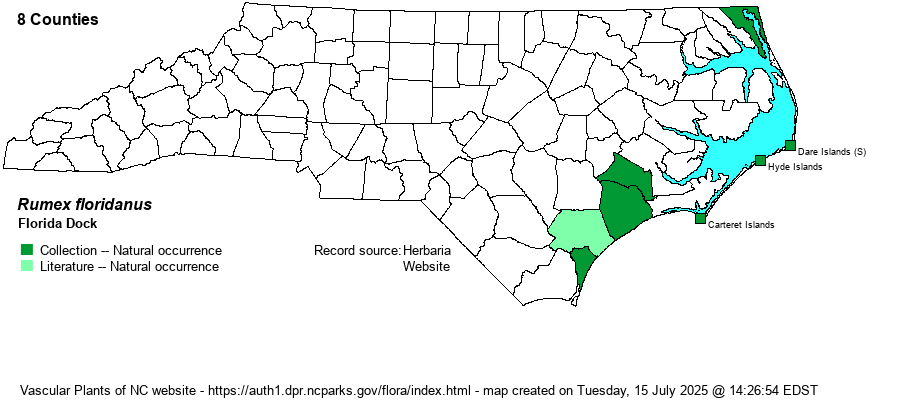| Author | Meisner | |
| Distribution | This is a rather controversial split from Rumex verticillatus -- some lump it entirely, others treat it as a subspecies. The Flora of North America website states that it ranges north to NC, and Weakley (2018) says it ranges north to NJ, but with a diamond shape code for NJ, DE, and NC (for uncertain provenance), but a square code for SC and southward (for native). There is a 2018 specimen for coastal SC (Charleston County), where it may well be native. In 2021 Eric Ungberg found a population on Mackay Island NWR in Currituck County, thus establishing a definite county for NC. Also in 2021, Bruce Sorrie checked specimens of verticillatus at SERNEC for broadly winged fruits and found "pure" floridanus in Carteret, Currituck, Dare, Hyde, Jones, New Hanover, and Onslow counties. However, mixed fruit morphologies occurred on other specimens in these same counties (and others on the outer Coastal Plain). In fact, sheets from New Hanover County (Leonard 4920) showed a complete range of fruit shapes. Therefore, the taxonomic status of floridanus is highly doubtful at any level and probably should be lumped within verticillatus.
Southeastern Coastal Plain, presumably native north to coastal SC and west to LA; apparently native to northeastern NC. Of uncertain provenance north to NJ.
| |
| Abundance | Uncertain abundance, though with a minimum of one current population known for the state of NC. A number of older specimen records appear to be this taxon (see Distribution), but as one editor (Sorrie) had difficulty determining which SERNEC specimens of labelled R. verticillatus actually "fit" within R. floridanus, it seems best to simply give it an Undetermined (SU) rank for abundance. The editors suggest no status for it, as it certainly has been overlooked or simply called R. verticillatus in the past (see comments under Distribution). However, in late 2022 the NCNHP placed the taxon on its Watch List as W2 (Questionable Taxonomy). | |
| Habitat | The 2021 population appears to be natural, as it occurs in a "remote marsh" along with Spartina cynosuroides, Schoenoplectus americanus, Eleocharis ambigens, and other native species. The presence of Phragmites (apparently the alien form) is inconsequential. | |
| Phenology | Plants were in fruit in late July. | |
| Identification | R. floridanus differs from verticillatus by its mature fruits obviously wider than long and by the denser inflorescence (less space between verticels). See comments above under Distribution. | |
| Taxonomic Comments | Has been treated as verticillatus subspecies floridanus (Meisner) A. Love. See comments above under Distribution.
| |
| Other Common Name(s) | None? | |
| State Rank | SU | |
| Global Rank | GNR [G5?] | |
| State Status | W2 | |
| US Status | | |
| USACE-agcp | FACW link |
| USACE-emp | FACW link |

